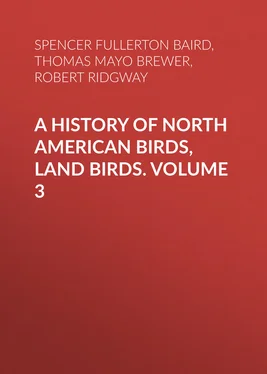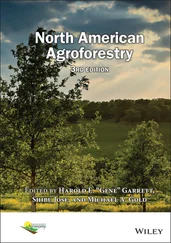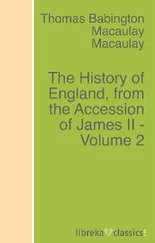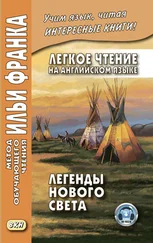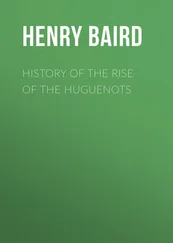Spencer Fullerton Baird - A History of North American Birds, Land Birds. Volume 3
Здесь есть возможность читать онлайн «Spencer Fullerton Baird - A History of North American Birds, Land Birds. Volume 3» — ознакомительный отрывок электронной книги совершенно бесплатно, а после прочтения отрывка купить полную версию. В некоторых случаях можно слушать аудио, скачать через торрент в формате fb2 и присутствует краткое содержание. Жанр: foreign_antique, Биология, foreign_edu, на английском языке. Описание произведения, (предисловие) а так же отзывы посетителей доступны на портале библиотеки ЛибКат.
- Название:A History of North American Birds, Land Birds. Volume 3
- Автор:
- Жанр:
- Год:неизвестен
- ISBN:нет данных
- Рейтинг книги:5 / 5. Голосов: 1
-
Избранное:Добавить в избранное
- Отзывы:
-
Ваша оценка:
- 100
- 1
- 2
- 3
- 4
- 5
A History of North American Birds, Land Birds. Volume 3: краткое содержание, описание и аннотация
Предлагаем к чтению аннотацию, описание, краткое содержание или предисловие (зависит от того, что написал сам автор книги «A History of North American Birds, Land Birds. Volume 3»). Если вы не нашли необходимую информацию о книге — напишите в комментариях, мы постараемся отыскать её.
A History of North American Birds, Land Birds. Volume 3 — читать онлайн ознакомительный отрывок
Ниже представлен текст книги, разбитый по страницам. Система сохранения места последней прочитанной страницы, позволяет с удобством читать онлайн бесплатно книгу «A History of North American Birds, Land Birds. Volume 3», без необходимости каждый раз заново искать на чём Вы остановились. Поставьте закладку, и сможете в любой момент перейти на страницу, на которой закончили чтение.
Интервал:
Закладка:
Dr. Cooper met with this species on the banks of the Columbia, east of the Dalles. The region was desolate and barren, and several species of Owls appeared to have been drawn there by the abundance of hares and mice. Dr. Suckley also met with it on a branch of Milk River, in Nebraska. It has likewise been taken in different parts of California, in New Mexico, among the Rocky Mountains, in the valley of the Rio Grande, at Fort Benton, and at Cape Florida, in the last-named place by Mr. Würdemann.
Dr. Cooper found this Owl quite common near San Diego, and in March observed them sitting in pairs in the evergreen oaks, apparently not much troubled by the light. On the 27th of March he found a nest, probably that of a Crow, built in a low evergreen oak, in which a female Owl was sitting on five eggs, then partly hatched. The bird was quite bold, flew round him, snapping her bill at him, and tried to draw him away from the nest; the female imitating the cries of wounded birds with remarkable accuracy, showing a power of voice not supposed to exist in Owls, but more in the manner of a Parrot. He took one of the eggs, and on the 23d of April, on revisiting the nest, he found that the others had hatched. The egg measured 1.60 by 1.36 inches. Dr. Cooper also states that he has found this Owl wandering into the barren treeless deserts east of the Sierra Nevada, where it was frequently to be met with in the autumn, hiding in the thickets along the streams. It also resorts to caves, where any are to be found.
Dr. Kennerly met with this bird in the cañons west of the Aztec Mountains, where they find good places for their nests, which they build, in common with Crows and Hawks, among the precipitous cliffs,—places unapproachable by the wolf and lynx.
On the Atlantic coast the Long-eared Owl occurs in more or less abundance from Nova Scotia to Florida. It is found in the vicinity of Halifax, according to Mr. Downes, and about Calais according to Mr. Boardman, though not abundantly in either region. In Western Maine, and in the rest of New England, it is more common. It has been known to breed at least as far south as Maryland, Mr. W. M. McLean finding it in Rockville. Mr. C. N. Holden, Jr., during his residence at Sherman, in Wyoming Territory, met with a single specimen of this bird. A number of Magpies were in the same bush, but did not seem either to molest or to be afraid of it.
The food of this bird consists chiefly of small quadrupeds, insects, and, to some extent, of small birds of various kinds. Audubon mentions finding the stomach of one stuffed with feathers, hair, and bones.
The Long-eared Owl appears to nest for the most part in trees, and also frequently to make use of the nests of other birds, such as Crows, Hawks, or Herons. Occasionally, however, they construct nests for themselves. Audubon speaks of finding such a one near the Juniata River, in Pennsylvania. This was composed of green twigs with the leaflets adhering, and lined with fresh grass and sheep’s wool, but without feathers. Mr. Kennicott sent me from Illinois an egg of this bird, that had been taken from a nest on the ground; and, according to Richardson, in the fur regions it sometimes lays its eggs in that manner, at other times in the deserted nests of other birds, on low bushes. Mr. Hutchins speaks of its depositing them as early as April. Richardson received one found in May; and another nest was observed, in the same neighborhood, which contained three eggs on the 5th of July. Wilson speaks of this Owl as having been abundant in his day in the vicinity of Philadelphia, and of six or seven having been found in a single tree. He also mentions it as there breeding among the branches of tall trees, and in one particular instance as having taken possession of the nest of a Qua Bird ( Nyctiardea gardeni ), where Wilson found it sitting on four eggs, while one of the Herons had her own nest on the same tree. Audubon states that it usually accommodates itself by making use of the abandoned nests of other birds, whether these are built high or low. It also makes use of the fissures of rocks, or builds on the ground.
As this Owl is known to breed early in April, and as numerous instances are given of their eggs being taken in July, it is probable they have two broods in a season. Mr. J. S. Brandigee, of Berlin, Conn., found a nest early in April, in a hemlock-tree, situated in a thick dark evergreen woods. The nest was flat, made of coarse sticks, and contained four fresh eggs when the parent was shot.
Mr. Ridgway found this Owl to be very abundant in the Sacramento Valley, as well as throughout the Great Basin, in both regions inhabiting dense willow copses near the streams. In the interior it generally lays its eggs in the deserted nests of the Magpie.
The eggs of this Owl, when fresh, are of a brilliant white color, with a slight pinkish tinge, which they preserve even after having been blown, if kept from the light. They are of a rounded-oval shape, and obtuse at either end. They vary considerably in size, measuring from 1.65 to 1.50 inches in length, and from 1.30 to 1.35 inches in breadth. Two eggs, taken from the same nest by Rev. C. M. Jones, have the following measurements: one 1.60 by 1.34 inches, the other 1.50 by 1.30 inches.
Strix brachyotus , Gmel. Syst. Nat. 289, 1789.—Forst. Phil. Trans. LXII, 384.—Wils. Am. Orn. pl. xxxiii, f. 3.—Aud. Birds Am. pl. ccccxxxii, 1831.—Ib. Orn. Biog. V, 273.—Rich. & Swains. F. B. A. II, 75.—Bonap. Ann. Lyc. N. Y. II, 37.—Thomps. N. H. Vermont, p. 66.—Peab. Birds Mass. p. 89. Ulula brachyotus , James. (Wils.), Am. Orn. I, 106, 1831.—Nutt. Man. 132. Otus brachyotus , (Steph.) Jard. (Wils.), Am. Orn. II, 63, 1832.—Peale, U. S. Expl. Exp. VIII, 75.—Kaup, Monog. Strig. Cont. Orn. 1852, 114.—Ib. Tr. Zoöl. Soc. IV, 1859, 236.—Hudson, P. Z. S. 1870, 799 (habits). Asio brachyotus , Strickl. Orn. Syn. I, 259, 1855. Otus brachyotus americanus , Max. Cab. Jour. II, 1858, 27. Brachyotus palustris , Bonap. List. 1838, p. 7.—Ridgw. in Coues, Key, 1872, 204. Otus palustris , (Darw.) De Kay, Zoöl. N. Y. II, 28, pl. xii, f. 27, 1844. Brachyotus palustris americanus , Bonap. Consp. Av. p. 51, 1849. Brachyotus cassini , Brewer, Pr. Boston Soc. N. H.—Newb. P. R. Rep’t, VI, iv, 76.—Heerm. do. VII, 34, 1857.—Cassin (in Baird) Birds N. Am. 1858, 54.—Coop. & Suckl. P. R. Rep’t, XII, ii, 155, 1860.—Coues, P. A. N. S. (Prod. Orn. Ariz.) 1866, 14.—Gray, Hand List, I, 51, 1869. Brachyotus galopagoensis , Gould, P. Z. S. 1837, 10. Otus galopagoensis , Darw. Zool. Beag. pt. iii, p. 32, pl. iii.—Gray, Gen. fol. sp. 3; List Birds Brit. Mus. 108.—Bonap. Consp. 51. Asio galopagoensis , Strickl. Orn. Syn. I, 1855, 211.
Sp. Char. Adult. Ground-color of the head, neck, back, scapulars, rump, and lower parts, pale ochraceous; each feather (except on the rump) with a medial longitudinal stripe of blackish-brown,—these broadest on the scapulars; on the back, nape, occiput, and jugulum, the two colors about equal; on the lower parts, the stripes grow narrower posteriorly, those on the abdomen and sides being in the form of narrow lines. The flanks, legs, anal region, and lower tail-coverts are always perfectly immaculate; the legs most deeply ochraceous, the lower tail-coverts nearly pure white. The rump has obsolete crescentic marks of brownish. The wings are variegated with the general dusky and ochraceous tints, but the markings are more irregular; the yellowish in form of indentations or confluent spots, approaching the shafts from the edge,—broadest on the outer webs. Secondaries crossed by about five bands of ochraceous, the last terminal; primary coverts plain blackish-brown, with one or two poorly defined transverse series of ochraceous spots on the basal portion. Primaries ochraceous on the basal two-thirds, the terminal portion clear dark brown, the tips (broadly) pale brownish-yellowish, this becoming obsolete on the longest; the dusky extends toward the bases, in three to five irregularly transverse series of quadrate spots on the outer webs, leaving, however, a large basal area of plain ochraceous,—this somewhat more whitish anteriorly. The ground-color of the tail is ochraceous,—this becoming whitish exteriorly and terminally,—crossed by five broad bands (about equalling the ochraceous, but becoming narrower toward outer feathers) of blackish-brown; on the middle feathers, the ochraceous spots enclose smaller, central transverse spots of blackish; the terminal ochraceous band is broadest.
Читать дальшеИнтервал:
Закладка:
Похожие книги на «A History of North American Birds, Land Birds. Volume 3»
Представляем Вашему вниманию похожие книги на «A History of North American Birds, Land Birds. Volume 3» списком для выбора. Мы отобрали схожую по названию и смыслу литературу в надежде предоставить читателям больше вариантов отыскать новые, интересные, ещё непрочитанные произведения.
Обсуждение, отзывы о книге «A History of North American Birds, Land Birds. Volume 3» и просто собственные мнения читателей. Оставьте ваши комментарии, напишите, что Вы думаете о произведении, его смысле или главных героях. Укажите что конкретно понравилось, а что нет, и почему Вы так считаете.
